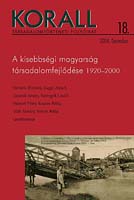Telepítések Dél-Szlovákiában a két világháború között
Slavic Colonization in Southern Slovakia between the Two World Wars
Author(s): Attila SimonSubject(s): History
Published by: KORALL Társadalomtörténeti Egyesület
Keywords: social history; 20th century; Hungary; Slovakia; Czechoslovakia; Hungarian minority; colonisation; Trianon Peace Treaty
Summary/Abstract: The paper discusses the processes of Slavic colonization in Southern Slovakia between the two World Wars. The first Czechoslovakian land reform conducted during the ‘twenties of the previous century formed and integral part of the national-democratic revolution that started in the Czechoslovakian Republic in 1918. Besides its indubitable social and economic motives, the land reform may be primarily derived from national objectives, which objectives are the most evident and the best discernible within the colonization endeavours carried out within its framework. The settling of Czech and Slovakian colonialists on the territories inhabited by Hungarians was carried out along nation-political and nation-strategic considerations. To ensure the success of the process, special attention had been paid to the selection of the large estates to be settled as well as the settlers. The colonization process led to a series of tensions, primarily between the Hungarian population and the Slavic colonialists, but it also brought to light antagonisms between the Czechs and the Slovaks themselves. Besides this, however, the settlement process had also enriched the social and economic structure of Southern Slovakia with new elements: previously unknown architectural solutions and farming methods gained ground. According to the final balance of the colonization process, between 1920 and 1930 more than 3 thousand Slovak and Czech families, i.e. some 15–20 people were settled in Southern Slovakia. Though this result fell short of the expectations, it nevertheless had a significant effect on the ethnic structure of the region. We may say that the colonization was the start of the process whereby the southern regions that had been homogeneously Hungarian-inhabited at the time of the Trianon Pact have become mixed populations by today.
Journal: Korall - Társadalomtörténeti folyóirat
- Issue Year: 2004
- Issue No: 18
- Page Range: 30-47
- Page Count: 18
- Language: Hungarian

